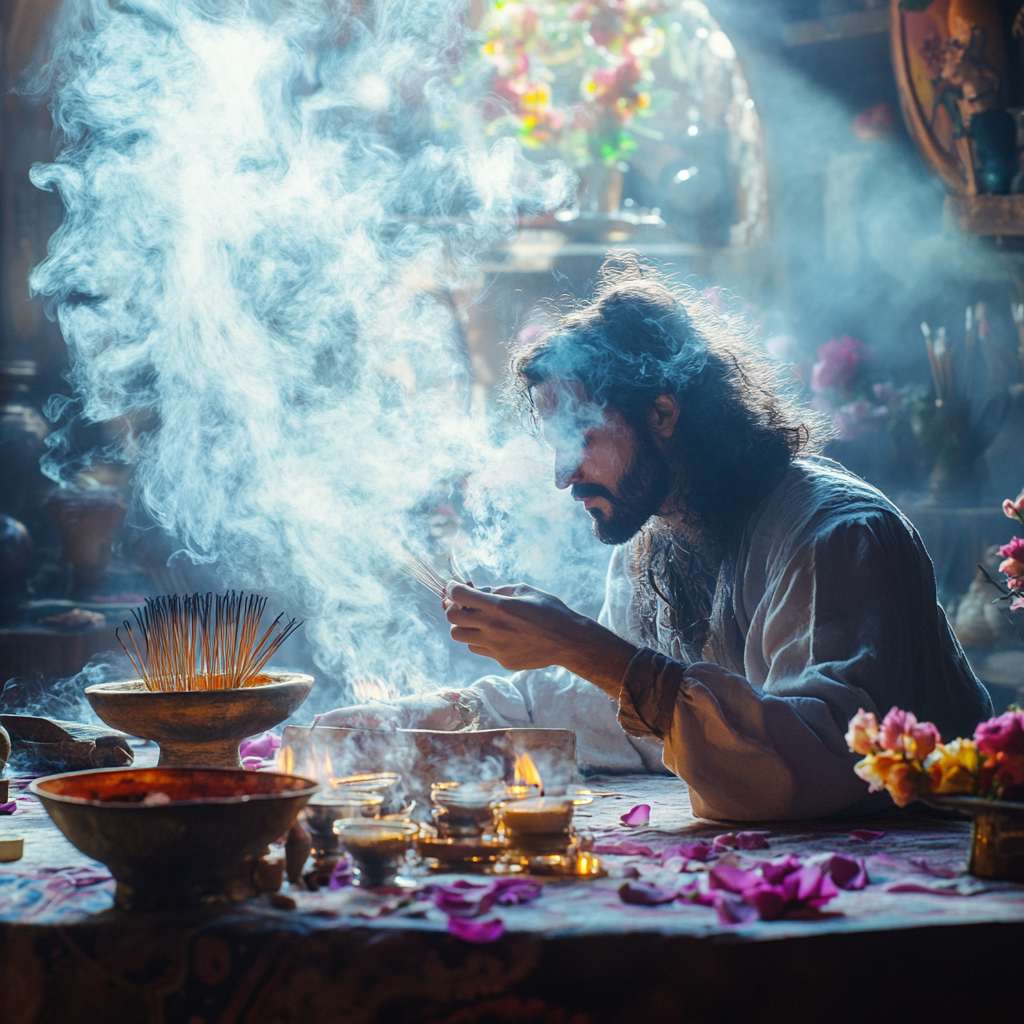Fragrances and incense have accompanied people since ancient times, playing a central role in rituals, everyday life and creativity. In the ancient civilisations of Egypt, India and Greece, incense was considered a bridge between the earthly and divine worlds. The Egyptians used aromatic oils and resins such as frankincense and myrrh not only for ceremonies, but also to create a special atmosphere, support and spiritual enlightenment.
In India, incense was used for meditation and the art of dance, emphasising their deep connection to the human world. Priests and poets used the smoke of fragrant sticks to tap into the cosmos and awaken inspiration. The Greeks, in turn, believed that fragrances helped awaken mental strength and creative energy. Incense was often burned in temples where philosophers and poets found peace to reflect and create great men. The poets Sappho and Homer, mentioned the scents of roses, incense and incense in their works as symbols of inspiration and harmony.
These ancient traditions laid the foundation for the perception of fragrances as a powerful tool that can influence the emotions and creative state of a person.
The Middle Ages: incense as a means of concentration and prayer
During the Middle Ages, incense took on a religious and meditative significance. Monasteries became major centres for the production of aromatic mixtures such as frankincense and sandalwood, which were used during worship and for working on sacred texts.
Medieval scribes working on manuscripts often burned incense in their cells to purify space and focus attention. One example is the Benedictine monks who used the aromatic smoke of incense to create a special atmosphere as they copied the Bible. Their work required incredible patience and attention to detail, and the aromas helped keep their minds clear and calm.
Artists creating icons and frescoes were also influenced by fragrances.
Andrei Rublev, famous for his Orthodox icons, worked in workshops where the smell of incense combined with the smell of paint and wax to create an atmosphere of peace and divine presence.
The Renaissance: the art and sensuality of fragrances
The Renaissance era was marked by a renewed interest in beauty, harmony and luxury. Incense and fragrances became part of life not only in temples but also in secular circles. Renaissance artists and poets drew inspiration from the smells that surrounded them in their workshops and rich palaces.
Leonardo da Vinci mentioned that the smells of flowers and aromatic oils helped him concentrate on his work and refresh his thoughts. Venetian painters such as Titian often worked in rooms where incense was used, creating a special atmosphere of cosiness and creativity.
Aromatic mixtures, oriental spices and rose water, became a symbol of luxury and sophistication. They were used not only for personal comfort, but also to create a special atmosphere during meetings with patrons and patrons of the arts who supported artists and poets.
The nineteenth century: Romanticism and fragrant symbols in poetry and painting
In the nineteenth century, Romanticism changed the perception of fragrances into symbolic emotions and memories. Romantic poets and artists looked to nature for inspiration, and the scents of flowering gardens, humid forests or fresh herbs became an important part of their development. Charles Baudelaire, one of the main representatives of French Romanticism, described odours as a bridge between reality and the world of dreams. In his collection The Flowers of Evil, he compared scents to musical chords, emphasising their ability to evoke emotions and memories.
In painting of the time, artists such as Claude Monet found inspiration in nature, surrounding themselves with the scents of flowers, herbs and moist earth. Monet often painted his famous landscapes in a garden filled with the scent of roses and lilies, which helped him to convey not only the colour but also the atmosphere of the moment on the canvas.
Poets, John Keats and Percy Shelley, described scents in their poems, linking them to romantic images of love, longing and nature. The scents of lavender, jasmine and rose became symbols of subtle experiences and creative flight of thought.
Contemporary art: fragrances as part of the creative process
Today, fragrances play an important role in the creative practices of artists, writers and designers. Modern creatives use aromatherapy to create a comfortable and inspiring atmosphere. Studies show that certain scents can improve concentration, reduce stress, and stimulate creativity.
Writers often choose lavender or sandalwood to create a calm atmosphere to work on texts. Artists prefer citrus and pine scents for a burst of energy and vigour. Renowned contemporary artist Anselm Kiefer uses scents in his installations to immerse the viewer in the atmosphere of his works.
Contemporary interior designers are also integrating scents into studio and gallery spaces to enhance the perception of art objects. Scents are no longer just an add-on – they become part of the art itself, forming an emotional connection between the viewer and the work.
Questions and Answers
Ancient civilisations saw fragrances as a bridge between the earthly and divine worlds. The Egyptians used aromatic oils and resins for rituals and spiritual enlightenment. In India, incense accompanied meditation and the art of dance, helping poets and priests achieve inspiration. The Greeks believed that fragrances awakened mental strength and creative energy.
Modern creatives actively use aromatherapy to stimulate creativity and reduce stress. Writers prefer the scents of lavender and sandalwood to create a calm working atmosphere. Artists choose citrus and pine scents for a burst of energy.
During the Renaissance, fragrances became a symbol of beauty, harmony and luxury. They were used not only in temples but also in social life. Leonardo da Vinci found in the scents of flowers and oils a means to focus and refresh his thoughts.

